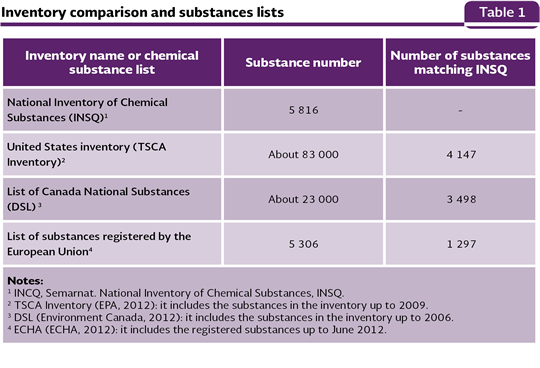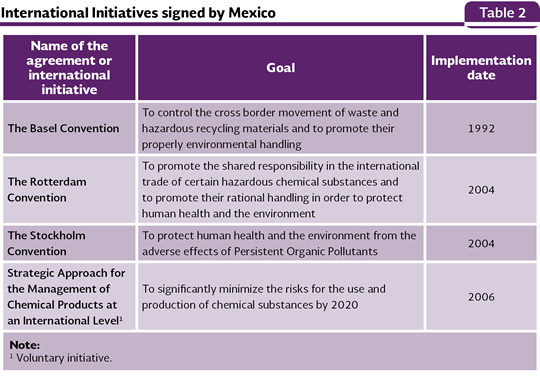The chemical substances may be found everywhere, all of the living creatures are made up of them and it is difficult to imagine any modern society activity where they are not present or that chemical products are involved, both at home and the working places and even in the recreation activities. From that, it is thought that such substances are or have been the basis of development and its use, in a large diversity of productive processes; it is identified as a factor that generates businesses, income and employment (Yarto et al., 2003).
At a global level, by July 2012, 67,295,000 chemical substances had been identified and it is estimated that about 15,000 new substances are daily incorporated to the register of the Chemical Abstract Service (CAS) of the United States (CAS, 2012). These substances allow controlling pests, healing diseases, preserving food, generating energy and they take part in a large amount of productive activities to generate goods (INE, 2003). However, these substances may also bring risks for the human health and the environment, many times due to their inadequate handling. They may alter the soil productivity, deteriorate the quality of the water supply sources and to affect the reproduction and development of aquatic and terrestrial species, besides their inadequate handling may cause serious accidents such as explosions, spills and fires.
Due to the former, the governments of many countries have worked in the development of regulation and information instruments for the prevention and to minimize the adverse effects of the chemical substances. Among the regulation instruments, the inventories created to know the universe of the chemical substances traded in a country are important. In general terms, they are defined as a list of chemical substances which are produced and imported to a country and they are linked to any type of register that supports its trading.
For the case of Mexico, the National Institute of Ecology from the Semarnat has worked in the elaboration of the National Inventory of Chemical Substances (INSQ), established in the beginning, as an information instrument made up using as a basis secondary information sources (Annual Operation Certificate, customs clearances, data from the National Association of the Chemical Industry, among others). As of today, the inventory has a list of 5,816 chemical substances identified in the national trade. It has information about the chemical identity, production and import volumes and ecotoxicological data of the substances. Since the procedure that yielded the INSQ is based on existing information sources and it is not a compulsory register, such inventory does not show the whole universe of substances. It is estimated that incorporated a third of the substances traded in Mexico.
As the INSQ is compared to the United States substance inventory (known as TSCA), or to the one from Canada (named Domestic Substance List, DSL) and the European Union registered substances, it is found that 71% of the INSQ substances are also found in the TSCA, 60% in the Canada inventory and 22% in the substance list registered in Europe (Table 1).

In order to identify the chemical substances that potentially could represent a risk for the environment, some criteria of environment relevance is applied; factors such as persistence1 and bio accumulation2 and the tocicity3 for the terrestrial and aquatic organisms. Taking into consideration the commons substances between the INSQ and the DSL from Canada, along with the available ecotoxicology information for the DSL substances (Environment Canada, 2012), 858 substances in the INSQ are identified as persistent and/or bio accumulative and toxic for aquatic organisms and 417 are inherently toxic to humans. As well, 84 substances the European Union rates as very high concerning because they are substances which may have serious and frequently irreversible serious effects on the human health and the environment, 50 of these substances are listed in the INSQ.
According to the CAS, as of today, just 295,096 chemical substances, at a world level, have been recorded in the trading inventory (CAS, 2012), for which there is limited information about their risks to the human health and the environment. In order to fill these information gaps and to evaluate the risks of the substances that go into the market, some countries have implemented a registration process under two principal schemes:
- National authorities must demonstrate what chemical substances represent a risk to human health or to the environment, so they may be authorized to be used under certain conditions. The new substances that will go into the market are subject to more stringent provisions than the ones from products which are currently traded in the market (existing substances).
- Importers and producers must assess the health or environment risks of the chemical substances which are traded or those new substances which are meant to be introduced in the market. Under this scheme, the registration requirements are the same for the new and existing substances, in other words, there is not a distinction among them.
It is recognized the necessity to implement in the country a registration procedure that may allow preventing and minimizing the risks of the chemical substances, and at the same time, it may allow updating and complementing the INSQ. Such procedure should consider the characteristics of the national market for chemical substances and take advantage of the environment relevant information generated at a global level. Currently, there is register of pesticides and vegetal nutrients; notwithstanding, the current environment regulation is mainly focused on the control of hazardous substances to lower the environment pollution.
Another information instrument about chemical substances of great importance is the Register of Emissions and Pollutant Transfer (RETC), which periodically report the emission and transfer, to the water, air, soil and ground, of 104 substances rated as national priority, because they may be persistent and /or bioaccumulative, toxic, carcinogenic, mutagenic and teratogenic. The RETC is updated by means of the information gathered through the Annual Operation Certificate, which is a compulsory report for the industries in the federal jurisdiction (Semarnat, 2012). Currently, the Semarnat is working on the creation of an Official Mexican Standard for expanding the number of substances subject to report and to establish a mechanism for incorporating additional substances to the register.
On the international agenda, Mexico is a signatory of many international binding initiatives focused on protecting the health of the people and the ecosystems against the adverse effects of the chemical substances (Table 2). Particularly, Mexico participated in the United Nations Environment Programed (PNUMA, 2012), held in June 2012, where it was acknowledged that a rational management of the chemical substances is fundamental for the protection of the human health and the environment. Likewise, it was confirmed the commitment of Mexico and the other signatory countries of the voluntary initiative called Strategic Approach to International Chemicals Management (SAICM), to meet in 2020 the objective to significantly minimize the adverse impacts of the chemical substances derived from their use and production.

Notes:
1 It is the capacity of a chemical substance to remain in the environment for a long time after being released, maintaining its dangerous characteristics.
2 It is the process through which the amount of a substance in an organism or some part of it proportionally increases with the expose time. Is the process by which the amount of a substance in an organism or part of the increases proportionally with the exposure time.
3 It is the inherent capacity of a chemical substance to damage living creatures, since the individual organism up to the ecosystem level.
REFERENCES:
Chemical Abstract Service (CAS). CAS Registry and CAS Registry Numbers. 2012. Disponible en:
www.cas.org/expertise/cascontent/registry/regsys.html. Fecha de consulta: julio de 2012.
European Chemicals Agency (ECHA). 2012. Substances of Very High Concern identification. Disponible en:
http://echa.europa.eu/addressing-chemicals-of-concern/authorisation/substances-of-very-high-concern-identification. Fecha de consulta: julio de 2012.
Environment Canada. 2012. CEPA DSL Categorization: Overview and Results. Canadá. Disponible en: www.ec.gc.ca/lcpe-cepa.
EPA. 2012. TSCA Chemical Substance Inventory. Disponible en:
www.epa.gov/oppt/existingchemicals/pubs/tscainventory/index.html. Fecha de consulta: julio de 2012.
PNUMA. El futuro que queremos. Conferencia de las Naciones Unidas para el Desarrollo Sostenible. Río de Janeiro. Documento A/CONF.216/L.1. Programa de las Naciones Unidas para el Medio Ambiente. Brasil. 2012.
Semarnat. 2012. Registro de Emisiones y Transferencia de Contaminantes. Disponible en:
www.semarnat.gob.mx/temas/gestionambiental/calidaddelaire/Paginas/retc.aspx. Fecha de consulta: septiembre de 2012.
Yarto-Ramírez M., Ize-Lema I., Gavilán-García A. 2003. El universo de las sustancias química peligrosas y su regulación para un manejo adecuado. INE-Gaceta Ecológica 69: 57-66. 2003.
Autoras:
Leonor Cedillo y Teresita Romero
Dirección de Investigación sobre Sustancias Químicas y Riesgos Ecotoxicológicos
Instituto Nacional de Ecología, Semarnat.
|